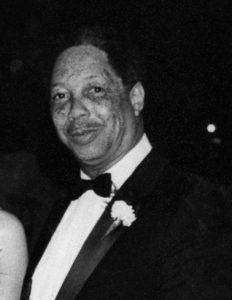(Mar. 3, 1928-Mar. 26, 2006). Sam Jones was born in Heidelberg, Mississippi, the son of Henry and Sallie Belle Jones. He graduated from Clark College in Atlanta, Georgia, in 1950. He earned his MA in Sociology in 1954 and MSW in Social Work in 1956 both from Atlanta University.
Jones began his long career with the Urban League in 1955 as industrial relations secretary and director of vocational education at the Cleveland Urban League. He served as executive director of the Pontiac, Michigan, Urban League from 1961-1963 and as executive director of St. Paul, Minnesota, Urban League from 1963-1966. In August 1966, Jones became the first president of the , a position he held until his retirement on December 31, 2002.
Under his aegis, the organization focused on its mission to elevate the social and economic progress of African Americans in Indianapolis while balancing the group’s non-partisan, interracial identity. Jones sought to improve the lives of all Indianapolis residents through education, housing, healthcare, and civil rights reforms.

Work with numerous Indianapolis community organizations helped Jones create synergies between the Urban League’s mission and the goals of other community organizations. He was a member of the (GIPC), the Near North Development Corporation, the Foundation, the Indiana Conference on Social Concerns and Citizens Complaint Advisory Board, and Indiana Convention and Visitors Association ().
By bridging other community agencies with the Urban League, Jones framed his organization as a network for information on urban issues. Indianapolis community leaders came to Jones and his agency for data about poverty, housing, health care, crime, citizenship education, and employment. Scholarships for higher education, job counseling and placement, community forums and conferences, and anti-drug programs for youth were all possible due to the scope of Jones’ civic engagement.
Jones was also a member of the , the Boy Scout Council of Central Indiana, Alpha Eta Boule, Omega Psi Phi, the Rotary Club, the (NAACP), the Quarter Century Club of the National Urban League and he was a 33rd Degree Mason—an honor the fraternity of the Scottish Rite of confers on a member who has made major contributions to society or to Masonry.
Over the course of his career with the Urban League, Jones completed several executive programs including those through the Harvard Executive Management Program, (IUPUI) School of Philanthropy, Indiana University Poynter Center Seminar on Ethics and Business, and Michigan State University School of Law Enforcement.
His civic efforts led to myriad honors. He received the Whitney M. Young Race Relations Leadership Award, the Distinguished Alumni Award from the National Association for Equal Opportunities and Higher Education, and the Sagamore of the Wabash Award.
He received honorary degrees from Vincennes University, Butler University, Martin University, the Christian Theological Seminary, and Indiana University.
Mayor Bart Peterson honored Jones by establishing the Sam Jones Race Relations Diversity Award to recognize a company that has shown outstanding commitment to diversity. In 2007, Peterson renamed a 1.8 mile stretch of a 4-laned divided highway in the Sam Jones Expressway. The segment runs from Raymond Street to High School Road just west of I-465 at the former passenger terminal at the .
Jones’ work continues at the 33,500-square-foot Sam H. Jones Center, located on the historic . Opened in 2001, the Indianapolis Urban League owns its permanent home which is adjacent to historical structures like the .

Help improve this entry
Contribute information, offer corrections, suggest images.
You can also recommend new entries related to this topic.





